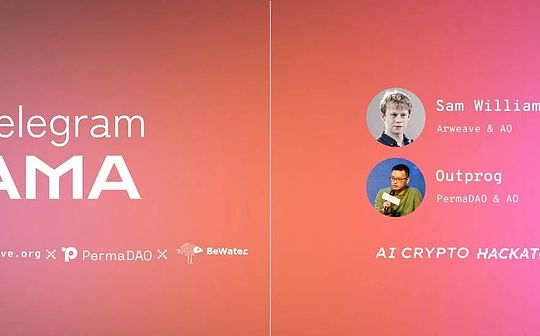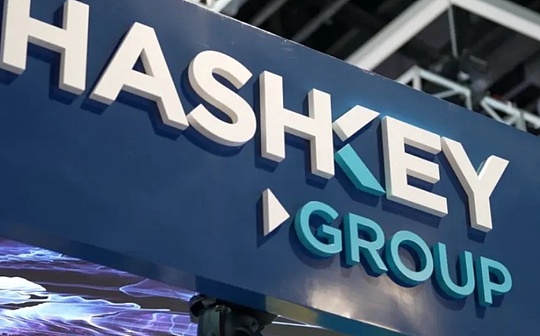
Source: Permadao
This time AMA is a part of the AI Crypto hacker hosted by Bewater, supported by the Permadao community.
This article is sorting out AMA content, divided into text and QA links.The text part is the dialogue between the host and SAM. The QA link is the issue of community users about AO.
Guest: SAM, Arweave & AMP; AO founder
host: OUTPROG, Permadao & amp; AO sponsor; lulu, bewater
text
Outprog:
Thanks to Lulu and Bewater for invitation.I am OutProg from Permadao, hosting today’s event.
As a decentralized storage infrastructure, Arweave has been stable for nearly 6 years since 2018.Arweave’s storage data also ushered in explosive growth like the currency price of BTC.
We all know that this year Arweave ecology has happened very important, that is,AO 的发布,标志着 Arweave 生态从去中心化存储转变为一个支持去中心化计算的全栈应用生态。
首先请 Sam 简要介绍以下自己,以及 Arweave 和 AO 的简要介绍。
SAM:
Thanks to Outprog, thank you for inviting!
About 7 years ago, we began to build Arweave as a permanent data layer to store all the most important knowledge and history of humans.The initial idea was basically the creation of “chain storage” -just like people tried on Bitcoin from the beginning, but they needed unlimited capacity expansion capabilities.To this day, 7 years have passed, Arweave now stores more than 5 billion pieces of data and is a “data pipeline” run by many web3 applications.
In the process, we found that decentralized calculation is “decentralized data replication” plus “verification”.When you run the Ethereum (or even Bitcoin) nodes, your computer only downloads the block from the peer network and verify them.
Because Arweave can permanently store any amount of data (just like the data set of Bitcoin and Ethereum), a question appears: If we add a verification layer, does this mean that we can achieve infinitely expanding smart contracts?
It turns out that the answer is yes?This product is AO.It is essentially a decentralized super computer running on ArWEAVE with unlimited parallel threads.
We hope to build a new, decentralized network space through the combination of Arweave+AO.The network space can be proven to be neutral and guarantee the right of users.
Outprog:
Thank you SAM for your introduction.We enter the first question.Today’s theme is AI, let’s discuss from AI.
We know that AO uses the Actor model for design. It is very interesting that in a paper [A University Modular Actor Formalism for Artificial Intelligence], the relationship between the Actor model and AI is mentioned.Can we consider the AO naturally applicable to the development of AI applications based on the ACTOR model?
SAM:
Yes, the ACTOR model is invented in the times when AI research has received great attention.At that time, the exploration of artificial intelligence took 60 years to improve, but the programming model of the ACTOR was quickly adopted and used to many non -AI devices.Now we are close to AGI, which makes the Actor model more reasonable.
In essence, the core idea of the ACTOR model is that each component of the system can be an independent, autonomous agent, and can be operated in parallel.This model and proxy -driven architecture fits very well because it simulates the real world: just like the current AMA chat, each of us is independent and autonomous, and we coordinate each other by sending messages.
AO uses the ACTOR model to introduce this idea into the calculation world.Each service in the system is autonomous and can be executed independently.When they want to coordinate, they are implemented by sending messages.
Outprog:
Yes, each “actor” (Actor) in the ACTOR model is like an agent, which reminds us of AI Agent.Can SAM say that the correlation between Actor Model and AI?
SAM:
That’s right!Agent == Agent == Actor.Therefore, it is very reasonable to use ACTOR -oriented as its hosting environment.
The most exciting point for AO is that it provides us with sufficient scalable smart contracts to host a complete large -scale language model.Our chief technology officer Tom and I have been conducting research and practice on the hosting of large language models on Arweave on the evening and weekends in the past few weeks:
https://github.com/samcamwilliams/aos-llama
Although it is not ready to make public announcements, if you want to know, this warehouse can be used as a preview.
Outprog:
It’s praise!I think the use case of SAM will soon show how the AI model is realized on AO!
SAM:
One idea: AO is a new network space form, which is very suitable for agents.Inside AO, the agent is an autonomous, sovereign individual unit.
We believe that the primary application of this technology will appear in the financial field.
In the past, most economic activities were actually “smart layers” -the settlement.These economic activities were done in the past, but now we can bring them into the intelligent contract environment and obtain the unstoppableness they provide.
Imagine that if all economic activities -not only settlement -can perform actions on the chain through an agent without trust.Now you can build smart contracts to provide users with a “algorithm trading” fund for autonomy.This has opened a huge design space that has never been released.
In the long run, we think it will be far more than that.This will be a “life body” that can perform the form of autonomy that can perform tasks(No matter how you describe).
Outprog:
Automation Finance and AI proxy finance are the direction worth exploring on AO!Let’s wait and see.
Enter the next question.At present, there are no examples of AI and Web3 that can be combined, and the technical architecture of AO has obviously broke through this limit.In addition to EVM and other chains, developers can use AO to create applications that are difficult to achieve in the past.
After the technical breakthrough, how will AO help the development of AI in the future?Will there be support and funding for AI projects?What role will AO get in the development of AI?
SAM:
The main suggestion is to actively seek cooperation!A large number of groups in the Arweave ecosystem are very willing to help build the development of projects on AO.recent,Community Labs launched AO Ventures, which is an incubator with a $ 35 million investment fund to support the development of projects on the Internet.
In Forward Research, we are also very happy to provide one -on -one support for people who build projects in the ecosystem.Just contact us, we will try our best to provide various help -from technical support, promotion to financial support, we will do our best.
Outprog:
Powerful ecological support!The last question.
The hacker pine hosted by Bewater is very helpful for the ecological development of AO developers.Permadao has also long been committed to the development of the Arweave ecological developer community.
We believe that in the future, there will be more offline AO ecological activities held in Asia, which may be hackers, incubators, or training camps.
What plans and ideas have Forward Research’s support for these activities?How to cooperate with Bewater AI Crypto Hackathon?Promote innovation and development together.
SAM:
In Forward Research, our core function is to build: whether it is an agreement or a community.The latter usually involves find the right person and then helps them promote it.
Q & amp; a
The following is the Q & A of community users in AMA
About “POS”
Adam lee:
I have some questions about AO.
1. I noticed that AO is still using POA’s centralized system.When will it be upgraded to POS or a more decentralized consensus mechanism?
2. I have not seen AO -related tokens.When will this part be upgraded?
3. Does AO have a roadmap?
SAM:
As we continue to develop, we will gradually transition most activities to POS.At present, it is not “centralized” -some developers are running their own SUS/CUS/MUS.As a developer, you can choose which “institutions” of trust.It is more “distributed” than centralization, but it is not decentralized -but I understand your point of view.AO itself is a data protocol on Arweave, so you can superimposed different security systems on it.
Once AO is implemented, a high -efficiency computing market will appear. People run CUS (computing unit). These units are responsible for calculating the process status in the network.
A great feature of AO is that each sub -network operating the network is completely flexible.There is no scalability limit for each network.The interesting fact is: yesterday we doubled the number of calculation units in the test network running for the Forward Research.Except for some processes running faster, no one noticed this change?In the future, we can expand to an arbitrary number of calculation units.
David dot:
Does AO tokens mean re -raising funds, and have it been given up to make AR more valuable?
SAM:
It is difficult to accurately understand your problem, but AO has no funding at all.We are pushing all the venture capital companies that want to invest in the project ecosystem built on it.
About “concurrent”
Siyuan han:
It sounds good!Thank you SAM.Can you introduce how AO supports the parallel process of any number?How does AO avoid traditional parallel execution problems, such as reading and writing conflicts?
Outprog:
ACTOR MODEL is a very mature model that processes concurrent and is also an architecture used by AO.The model was proposed in 1973 and was implemented in Erlang programming language.
For more documents about Actor Model, you can view:
https://en.wikipedia.org/wiki/actor_model
You can also view the AO specification document of Permadao translation:
https://permadao.com/permadao/ao-1353 CC109 D434941 A6757560 EF35 DCC2
SAM:
I am sure Telegram, we are using it to chat with AMA now, and we also use ACTOR MODEL programming inside!
Siyuan han:
Therefore, AO avoids the problem of reading/writing conflict at the calculation level.If AO has the ability to deal with transactions like a traditional high -concurrency system and perform thousands of or tens of thousands of threads at the same time, how do it handle the working load at the disk IO level?Can you introduce AO’s storage and data engine technology in detail?
Outprog:
Rollup uses Rollup technology similar to Ethereum to bundle data to Arweave.
SAM:
Yes!The data of each process is “rolled” to Arweave. Arweave is specifically designed to coordinate the large -scale copy of the information in the point network.
Therefore, when building AO, we can say to some extent that disk I/O coordination is “free” (because we have spent 6 years to build it?).
About “load balancing”
Kevin zhang:
Will there be many processes to process AI in the future?How to maintain load balancing?
Outprog:
My point is that MUS (AO’s messenger unit) is similar to Nginx in the traditional web2, and the load balancing is distributed in countless MUS. After POS is implemented, CUS will share all calculations.Just like the elastic expansion of K8 S.
SAM:
Yes!MUS is the user’s entrance, and CUS is “calculated cloud”.
About “GPU Computing Power”
Ai:
If we perform some AI applications in AO, such as AI video generation, can the AO ecosystem solve the problem of insufficient GPU computing power?
I didn’t see the AI demonstration.Does AO have GPU computing power?
SAM:
You cannot use the GPU directly, although the APUS team is studying this issue.At present, only CPUs are used because WASM is running on the CPU, providing us with a certainty calculation result -if you want to be authenticated by smart contracts, this is critical.
Jason Wu (APUS):
As far as I know, there is no yet.APUS network is providing AO with GPU computing power.We will make some simple demonstrations.Images can currently generate images.Large language models and video generation has not yet been opened.
About “consensus and transaction order”
Miami Fish:
How does the SU verify the request and submit it to CUS for processing.
Outprog:
SUS is used to allocate NONCE, and the calculation results obtained by CUS are performed in the exact order of Nonce.
This is a papers related to MSG, which is also in the AO specification:
https://groups.csail.mit.edu/tds/papers/lampson/Forte93.pdf
SAM:
As @outprog said, SUS provides a Slot-Assignment (time slot slot) for each message.In the POA test network, you need to trust your SU, but if you are willing, you can even run it yourself.In a complete POS network, you will start with the correctness of S, and you can “return” to Arweave consensus mechanism (just like “Back L1” in Rollup) when you have any problems.
Miami Fish:
Thanks.So in POS, will the SU allocate automatically (like who receives my request first)?I am thinking about more problems about financial applications. For example, in the liquidation incident, different people try to submit a liquidation request in about the same time, so who’s request will be processed first, which will affect the results of others.
SAM:
The deployee of the process can choose the SU -whether it is the developer or another process generated as the “child” process.
After POS, if the Su stops processing the message, you can “challenge” them in the AO-SEC Origin process, asking for a slot allocation.If they do not do this, the process will become a “unable to host” state, and then it will be a new host to solve this problem through the SU “bidding”.
There are many details in it, but this is a macro picture.It allows each process in AO to inherit the flexibility and anti -review of Arweave. At the same time, the process can run on a high -speed SU?
Okay, I need to leave now.I wish you all a happy programming!








